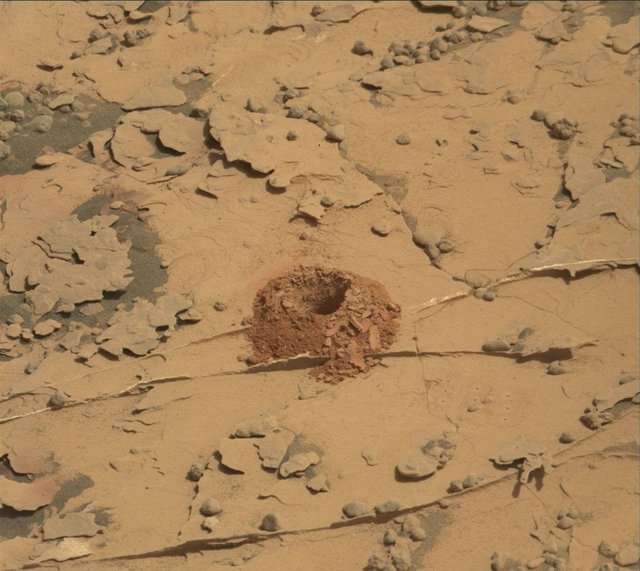Building Blocks of Life Discovered on Mars
In a press conference this week NASA revealed a new discovery made by the Curiosity Rover on the surface of Mars. NASA had announced the press conference a couple of days ago. While they kept the details secret it was anticipated by many observers is that the revelations were related to the drill of the Rover. This device had given NASA problems from the very beginning. The continuously had issues with the electric system and recently the drill shaft started malfunctioning. A couple of weeks ago the engineers reported that they managed to fix the drill. This meant that Curiosity could finally drill again after almost a year of inactivity of the device.

Image Credit: NASA/JPL-Caltech/MSSS
After all the problems with the drill NASA now finally got lucky and found something extraordinary. In the press conference on Thursday morning, scientists revealed that they had detected complex organic compounds in a piece of Martian rock they had drilled into. The scientists had decided to investigate the bed of an ancient lake that was filled with water about 3 billion years ago. The presence of the organic matter in the lake bed suggests that Mars was rich in carbon compounds all those years ago.
The question remains of the origins of the organic compounds. The onboard lap of the Curiosity rover is not equipped to collect enough information to answer this question. We know that some comets contain organic matter and it could be possible that they deposited the matter on the Mars surface. The other alternative is that the compounds were created by chemical reactions with the rock. Given the right conditions, rock surfaces can act as catalysts for organic chemical reactions. It also can't be ruled out that the compounds originated from life forms that existed in the ancient lake. This, of course, would be the most sensational finds of all.
Even if the chemicals found in the lakebed were not from ancient life forms the organic compounds could still have served as food for any life that might have existed. It is likely that simple life forms will have fed on naturally occurring organic chemicals. As Jennifer Eigenbrode, a biogeochemist at Nasa’s Goddard Space Flight Center in Maryland puts it “We know that on Earth microorganisms eat all sorts of organics. It’s a valuable food source for them.”
Some years ago curiosity already reported on the discovery of organic compounds. Back then, however, the readings were ambiguous and it could not be ruled out that the measurement was due to some contamination inside the instrument. This time around the measurement was very clear and the presence of the organic compounds can be confirmed with high reliability. As Eigenbrode puts it, “While we don’t know the source of the material, the amazing consistency of the results makes me think we have a slam-dunk signal for organics on Mars.”
When the Curiosity Rover was built it was designed to look for these kinds of signals of organic matter on Mars. It contains a drill and a shovel with which it can take probes from the Martian soil. The probes are then heated inside an oven and the gases released by this heating process are analysed. At temperatures between 500 and 820 centigrade, the spectrometer detected traces of aromatic, aliphatic and thiophenic vapours. Due to the fact that these vapours are only released in the heating process, the scientists are pretty certain that they originated from larger organic molecules.
While these discoveries do not confirm the existence of life on Mars, they show that the building blocks of life were present on our neighbouring planet in the past.
Release the Kraken! You got a 16.88% upvote from @seakraken courtesy of @plasticmars!